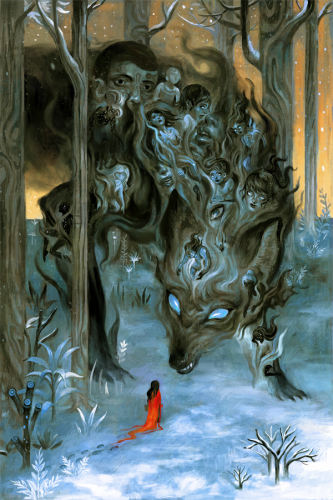I am not trying to antagonize Robert Silverberg or anything, but there are no men in my best-of-October-and-November column. Which is a good reminder of why I am getting so heavily back into speculative fiction after some time spent canoodling with literary fiction: Though the black spec fic and publishing diversity numbers make it very clear that we have a long way to go yet, it is much much easier to find SFF by people who aren’t white or male than when I was a kid trying to discover if SFF wanted me there. And that’s what I’m grateful for, this November.
(Some other month, when the holiday spirit is not upon me, we’ll talk about what I’m resentful of.)
Now, to the stories!
Because I am predictable, I was particularly in love this month with two stories that played around with timeline and format. “Toothsome Things,” by Chimedum Ohaegbu (2408 words, Strange Horizons), retells the story of Little Red Riding Hood.

At first it appears to be a retelling from the wolf’s perspective:
Come closer. Stop struggling. That red is lovely on you, though I must admit it was far lovelier on your Grandmother Marie, and truly how could you confuse us with her, can’t you see our eyes, our nose, our teeth—the better to eat you with, my dear. Couldn’t you see them?
(Which I already love.)
But then Ohaegbu turns the perspective a little, and we begin to see that there is more inside the wolf than malice. We begin to see that generations of women and hunters and stories have made this wolf. The writing’s also gorgeous. Oh, it’s so good and strange and I liked it so much. If you are a fan of Helen Oyeyemi at her strangest, “Toothsome Things” is for you.
Sarah Gailey’s very, very cool story “Stet” (2000 words-ish?, at Fireside Fiction) comes in the form of a textbook passage about the algorithms and ethics of self-driving cars. The real story’s in the footnotes (and the Track-Changes comments between the author of the fictional passage and her editor), where we get an increasingly horrifying view of the events that informed the author’s citations.
“Stet” is what I hoped for when people first started talking about hypertext stories. I was still a child at the time but I had hopes and dreams of stories like “Stet” that would take the possibilities of a web interface and use them to experiment with the form of narrative. (That is not exactly how little me articulated it to herself, but that’s the gist of what I wanted.) Most people haven’t done this because it’s hard and books are already perfect storytelling vectors anyway, but “Stet” called to something deep in my heart.
It’s also a devastating indictment of both attention culture and the technology industry’s assumption that if they can do something they should, giving very little attention to the ethical implications of the products they’re producing and the choices they’re making. I did have a slightly hard time with the formatting on this one, which led to a suboptimal emotional timeline while reading. You can click through to the editor’s comments from the pop-up that appears when you’ve clicked on an ellipsis, and I didn’t realize that.
Aliette de Bodard’s “In Everlasting Wisdom,” reprinted at Clarkesworld (5776), reminded me why Aliette de Bodard is quickly becoming a favorite author. Our protagonist, Ai Thi, has been implanted with a parasite (“the appeaser”) and sent out to issue propaganda on behalf of the Everlasting Emperor. When she meets a woman called Hoa who resists, she and the appeaser begin to reassert their free will. It’s a story that requires its characters to rethink what they’ve been told and who they want to be, which is my very favorite kind of thing.
In Suzanne Palmer’s “Thirty-Three Percent Joe” (Clarkesworld, 7923 words), an array of cybernetic implants work together to rescue a man called Joe, who is perpetually wounded in battle, patched up with new cybernetic parts, and sent right back out to fight again. As with Palmer’s delightful “The Secret Life of Bots,” this story mixes humor and pathos and makes us care not only about Joe, but about his body’s control unit, his various robot limbs, and his cranky, old-fashioned spleen. Prepare to be charmed.
Though A. Merc Rustad’s “How to Become a Robot in 12 Easy Steps” (reprinted at Lightspeed, 5010 words) has a whimsical title, it’s a really heartbreaking story about a person named Tesla who wants to be a robot. Or maybe Tesla doesn’t want to be alive at all. Rustad’s depiction of depression and alienation from one’s body are vividly resonant. As I’m coming to find is typical for Rustad’s fiction, the ultimate message is hopeful even in a story as sad as this one. Tesla hasn’t found a solution that eliminates their pain, but they do have a solid and loving support network, and hope for the future.
Oh! And this one also has a nontraditional narrative structure! I LIKE WHAT I LIKE, OKAY?
(If you enjoy Rustad’s work, they have a short story collection out now! It’s called So You Want to Be a Robot, which I presume means lots more of this kind of story. Yay!)
My pal Renay has always been a huge advocate for Madeline Ashby, and while I’ve liked the worldbuilding in her books a lot, I haven’t always connected emotionally. “Death on Mars” (reprinted at Clarkesworld, this is a weirdly reprint-heavy month, 8221 words) changed all that. An all-women mission to Mars is interrupted by the arrival of a computer scientist named Cody Marshall, who has come to debug an important piece of equipment. But he also comes bearing unwelcome news. I loved the character dynamics in this story and got real fucking emotional at the end.
What short fiction have y’all enjoyed lately? And is it in FIYAH? Because I got my Hulu subscription for very very cheap this year, which means I have some spare subscriptions-to-things money to play with. FIYAH Lit Mag is on the top of my list. Stand by for updates.
